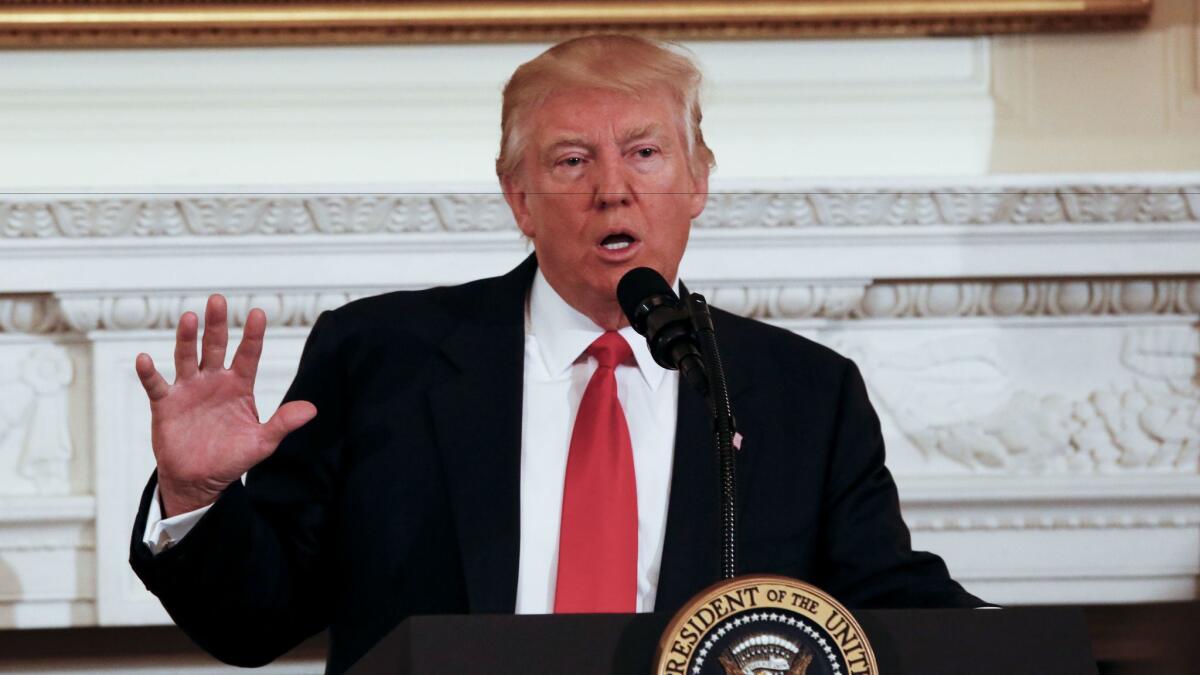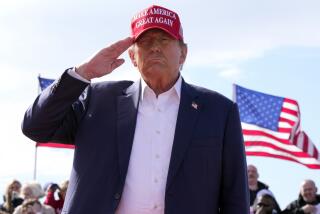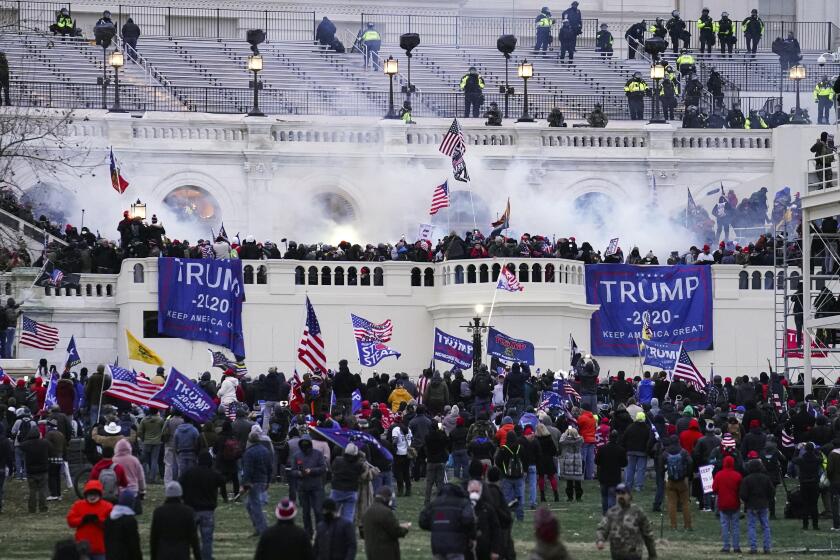In first major address to Congress, Trump will demand more military spending and cuts to domestic programs

President Trump vowed to use his first joint address to Congress on Tuesday to call for a dramatic $54 billion increase in military spending, coupled with an equally large cut to domestic programs that could gut some core functions of the federal government, setting up his most concrete blueprint yet for reordering the nation’s priorities.
Though Trump’s proposal will likely be altered significantly in the coming debate between the Trump administration and lawmakers in both parties, it represents the kind of bold initiative that Trump relishes as he prepares for another milestone early in his term. The speech, which takes the place of a State of the Union address in a president’s first year, will be Trump’s most formal since his inaugural address, a dark and relatively short speech that framed his presidency as emerging from a nation marked by “rusted-out factories scattered like tombstones.”
Though Trump has flouted formal traditions in other venues, speaking extemporaneously to obsess on the size of his electoral victory or inaugural crowds or to spar with the press, the batch of policies he previewed Monday suggests that he will at least come equipped Tuesday with a script that uses the address as other presidents have: to advocate for his agenda. For Trump, that includes a replacement for Obamacare, a sharp cut in federal regulations and an increase in federal spending on military and law enforcement.
“This is a landmark event, a message to the world in these dangerous times — of American strength, security and resolve,” Trump said Monday in a speech to most of the nation’s governors, who were in Washington, D.C., for their annual winter gathering.
Yet Trump continued to send mixed messages on spending.
He again called the nearly two decades of war in the Middle East a failure, as he has repeatedly.
“We have to start winning wars again,” he said, explaining his call for an increase in military spending that would amount to nearly 10%. It is geared to allow the armed services to rebound after several years of cuts known as sequestration forced by a failed negotiation between the Obama administration and the GOP-controlled Congress.
But at the same time, he lamented the costs so far of fighting in the region, which he put at $6 trillion.
Trump’s biggest challenge, however, will be finding money to cut elsewhere in the budget, which his administration has yet to detail. He promised in his campaign to protect Social Security and Medicare and aides said the current spending proposal would not affect those programs.
His advisors have said they would target foreign aid, a move opposed Monday by 121 retired admirals and generals and one that could put him at risk of undercutting his strong ties with Israel, an ally that is the top recipient of such funding. Yet even if Trump finds a way to cut foreign commitments, the entire category still represents only about 1% of the entire budget.
That would likely mean a cut of at least 10% to other portions of the budget — including environmental protection, diplomacy, education and job training — which have already absorbed sequestration cuts of their own since they kicked in in 2013.
Cutting some programs, such as heating assistance, public housing and grants to communities that help the poor, could have a disproportionate impact on the group of Americans whom Trump has labeled the “forgotten man and the forgotten women” hit hardest by the loss of manufacturing jobs.
“These are all core functions of government,” said Marc Goldwein, senior vice president of the Committee for a Responsible Federal Budget, who has advised Congress on deficit reduction.
At the same time, Trump repeated his promise on Monday to rebuild the nation’s infrastructure, but has yet to explain how he would do so without increasing the size of the deficit. Spokesman Sean Spicer said the program would be negotiated separately with Congress as part of a longer-term deal.
Trump will also make a separate request to Congress to pay for his promised wall on the Mexican border, said Trump’s budget director, Mick Mulvaney. The cost is estimated at $12 billion to $38 billion if the administration were to build along the entire 2,000-mile border.
Mulvaney did not rule out making deeper cuts to Social Security and Medicaid, saying the discussion would come as part of the debate over changing the tax code. Yet Trump also promised again Monday to initiate a major tax cut as part of that process, further complicating efforts to trim the deficit.
Trump seemed eager to put off many such details. Mulvaney called the military proposal top-line numbers and said the full budget would not be released until May. Congress, which has had a hard time passing budgets that cut popular programs even under GOP leadership, may reject some or all of Trump’s plans. Because the sequester was written into law, Republican Senate leaders would need Democratic support to reach the 60 votes necessary to reorder spending.
Trump said his speech would also emphasize his efforts to reduce government regulation, which has put him at odds with environmental advocates but in sync with many traditional conservatives in his own party.
Still, Trump’s roll-out seems geared more toward setting up a debate than articulating a full-blown agenda. He and his aides have stressed repeatedly that he is “keeping his promises.”
“We are taking his words and turning them into policies,” Mulvaney said.
Trump is single-mindedly focused on that goal, forcing his staffers to go through a checklist of campaign promises, said Chris Ruddy, a Trump confidante and founder of the conservative website Newsmax, calling it a “shotgun approach.”
“If Congress doesn’t go along with this, that’s their problem in his mind,” Ruddy said.
Ruddy said he believes Trump is a bit too anxious, failing to leave time to think through how the military should spend the money or, with his flood of executive orders in his initial weeks, bring Congress along on his goals for beefing up border enforcement.
Still, Democrats have also expressed an eagerness to debate over promises. House Minority Leader Nancy Pelosi has begun using the Twitter hashtag #brokenpromises to criticize Trump. Senate Minority Leader Chuck Schumer said Monday that “Trump fully intends to break his promises to working families by taking a meat ax to programs that benefit the middle class.”
The president’s budget plan means “helping the wealthy and special interests while putting further burdens on the middle class and those struggling to get there,” Schumer said.
Trump is certain to get backing for military spending increases from defense hawks in his party.
The Republicans who lead the Senate and House armed services committees, Sen. John McCain of Arizona and Rep. Mac Thornberry of Texas, called Trump’s increase too small, given the cuts absorbed in recent years. The Pentagon’s budget fell by a total of more than $100 billion between 2011 and 2014, causing top U.S. military leaders to gripe about the struggle to fight the Islamic State militant group and other terrorists while also staying prepared to confront threats from Russia and China.
“With a world on fire, America cannot secure peace through strength with just 3% more than President Obama’s budget,” McCain said in a statement. “We can and must do better.”
In September, Trump called for adding more than 80,000 Army soldiers to get to 540,000 on active duty. He wanted to increase the number of active-duty Marines to 200,000 from the current 182,000. He also wanted to increase the Navy’s ships from 287 to 350, and add to the Air Force’s fighter jet fleet by two dozen, to 1,200 aircraft.
But the party is no longer unanimous in that position. In recent years, deficit hawks have gained influence, blocking attempts to restore cuts made as part of the sequester. And other GOP members of Congress have made clear they are unwilling to pay for increased defense spending by cutting other domestic programs, especially state and local services.
Staff writers W. J. Hennigan, Lisa Mascaro, Brian Bennett and David Lauter contributed to this report.
Twitter: @noahbierman
ALSO:
Trump says Hollywood’s obsession with him led to best picture Oscar gaffe
Trump calls Russia talk ‘fake news’ as calls for special prosecutor grow louder
More to Read
Get the L.A. Times Politics newsletter
Deeply reported insights into legislation, politics and policy from Sacramento, Washington and beyond. In your inbox three times per week.
You may occasionally receive promotional content from the Los Angeles Times.







